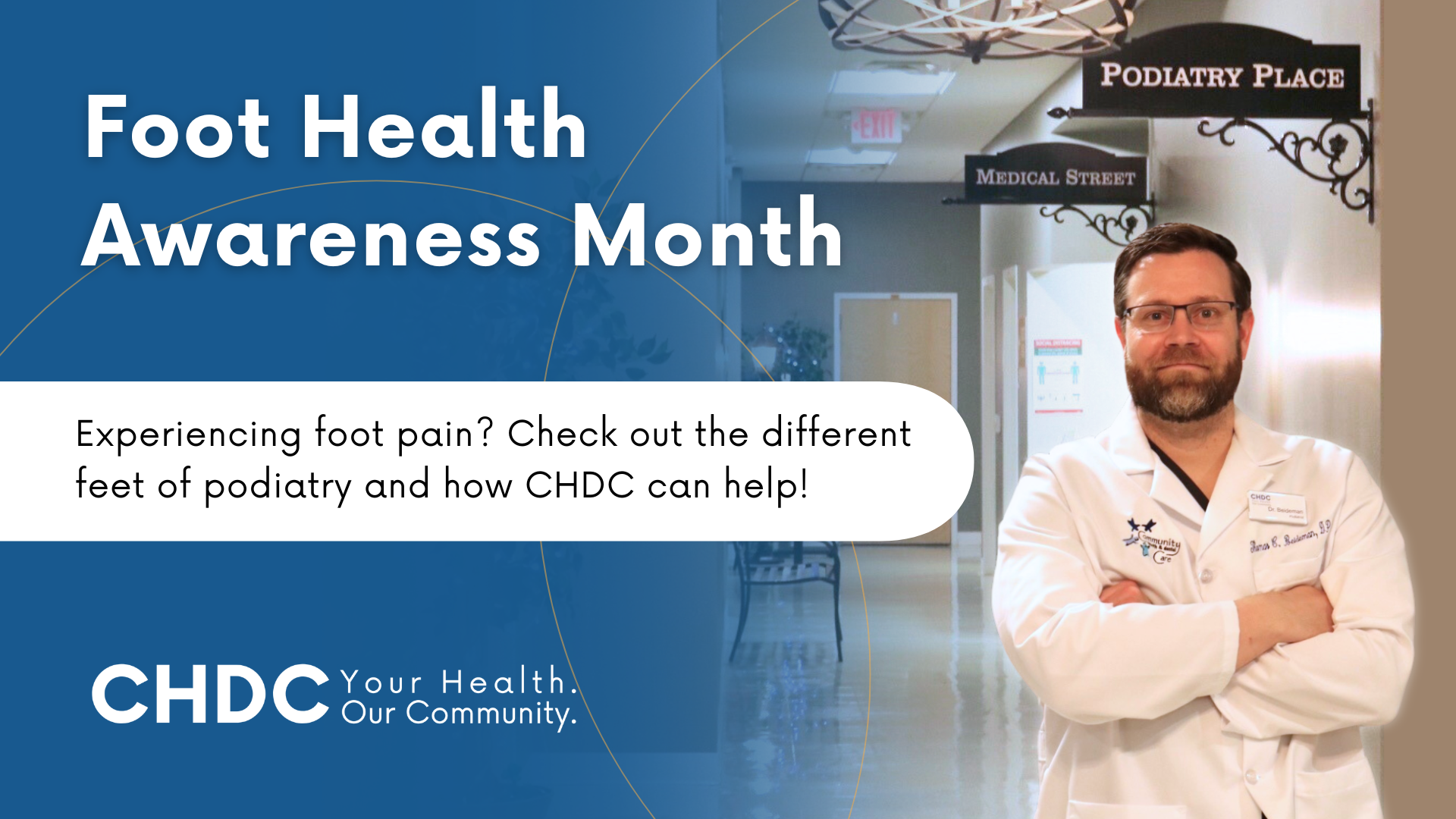Recent Posts
Foot Health From Bunions to Blisters
A Guide to Common Foot Problems & How CHDC Can Help
Did you know that taking good care of your feet can improve your overall health and well-being? It’s true! Properly caring for your feet can help you take steps toward becoming healthier and living happier. Thank you to CHDC Podiatry Provider, Dr. Beideman, for offering insight on this blog post.
Bunions
A bunion is a bony bump that can develop at the base of the big toe. Bunions cause the big toe to shift towards the second toe and, in severe cases, make the toes overlap. Other common symptoms associated with bunions are redness, swelling, callus formation, limited toe movement, and difficulty finding shoes that fit comfortably. Genetics are the leading cause of bunions, but injuries and improper shoe gear can also contribute to the formation or worsening of an existing bunion.
Heel Pain
Heel pain is one of the most common foot conditions. There are many causes including injuries, overuse, improper footwear, or lack of support. Some conditions that cause heel pain include plantar fasciitis, Achilles tendonitis, Sever’s Disease, bursitis, and heel fractures. Regardless of the cause, heel pain can make walking uncomfortable and difficult. Speaking of uncomfortable, continuing to irritate a condition like plantar fasciitis can cause a bony growth, also known as a heel spur, to form on your heel bone. Heel pain can affect anyone, though it’s more common in middle-aged adults, athletes, those who are overweight, and those who are on their feet for extended periods of time.

Blisters
Blisters are fluid-filled sacs, almost resembling a bubble, that form on the upper layers of the skin. They can be caused by friction or rubbing, burns, allergic reactions, infections, auto-immune conditions, and genetics. Most blisters that appear on the feet are due to burns or friction, like a sunburn from too much exposure or the back of your shoe rubbing each time you take a step. Common symptoms of blisters include pain or discomfort, itching, redness, swelling, and drainage if the blister has ruptured. Blisters can affect anyone, especially older adults, athletes, and those with diabetes. It’s important to remember to wear properly fitting and comfortable shoes, keep your feet dry, avoid prolonged pressure in the same area, and protect yourself from the sun with sunscreen and clothing.
Plantar Warts
Plantar warts are a contagious and painful skin growth that is primarily caused by the human papillomavirus (HPV) and are found on the soles of your feet. It’s commonly spread through direct contact with the wart or by touching a surface contaminated with HPV. Some may go away on their own, but others may require medical attention. Plantar warts can affect anyone but are far more common in children and teenagers, those with a weakened immune system, and those who walk barefoot in public areas.
Athletes' Foot
Don’t let the name fool you; athletes’ foot can affect anyone, not just athletes. Athletes' foot is a fungal skin infection that begins in between the toes, thrives in warm and moist environments, and can be spread through contact with infected feet, surfaces, and shoes. Common symptoms include itching between the toes, redness, scaling or peeling of the skin, blisters, a cracking or burning sensation, and in severe cases, thickened, discolored toenails. Men and those over the age of 60 are more prone to athlete’s foot, especially if they suffer from diabetes, sweaty feet, and other foot problems. Be sure to use extra caution in warm, humid climates and public areas such as locker rooms, showers, and swimming pools, as these areas can increase the risk of athletes’ foot.
Ingrown Toenails
An ingrown toenail is just as it sounds. It’s when the edge of a toenail starts growing into the surrounding skin and causes redness, inflammation, and if left untreated, infection (pus/drainage). The most common cause of ingrown toenails is improper nail trimming, followed by tight shoes and injuries. People of any age can get an ingrown toenail; however, those who wear constricting shoes, such as athletic shoes and high heels, older adults with diabetes and poor circulation, and children, teenagers, and young adults with sweaty feet are more likely to experience ingrown toenails.
Foot Health & Diabetes
From CHDC Podiatrist, Dr. Beideman: Diabetic patients have a high incidence of peripheral vascular disease and neuropathy. Both of these conditions put them at higher risk for injury, infection, and amputation. Regular foot screenings help to identify risk factors and lower the risk of infection/amputation. Some diabetics qualify for regular routine services by a podiatrist or even diabetic shoes with custom molded insoles in an effort to help further reduce their risk. Coverage for these services are dictated by a patient specific insurance and they would require a diabetic foot exam to determine their qualification. As a general rule, diabetics should have a foot exam at least yearly, but should contact their foot doctor if they notice any cuts, scrapes, bruises, or other lesions that do not appear to be healing quickly/appropriately or if they start having new symptoms like numbness, tingling, burning, or pain in their feet.
How Can CHDC Help You Get Back On Your Feet?
At CHDC, patients receive compassionate care for their feet so that they can take steps toward a healthier life. Our podiatrists provide patients with individualized treatment plans that best suit them and their unique podiatric needs. We encourage patients, especially those with diabetes, to receive a yearly foot exam to ensure healthy, happy feet. Our podiatry team has over 60 years of combined experience and can provide confident and comprehensive foot and ankle care.
If you would like to schedule an appointment at CHDC, please call 610-326-9460 or visit our Become Our Patient page.
